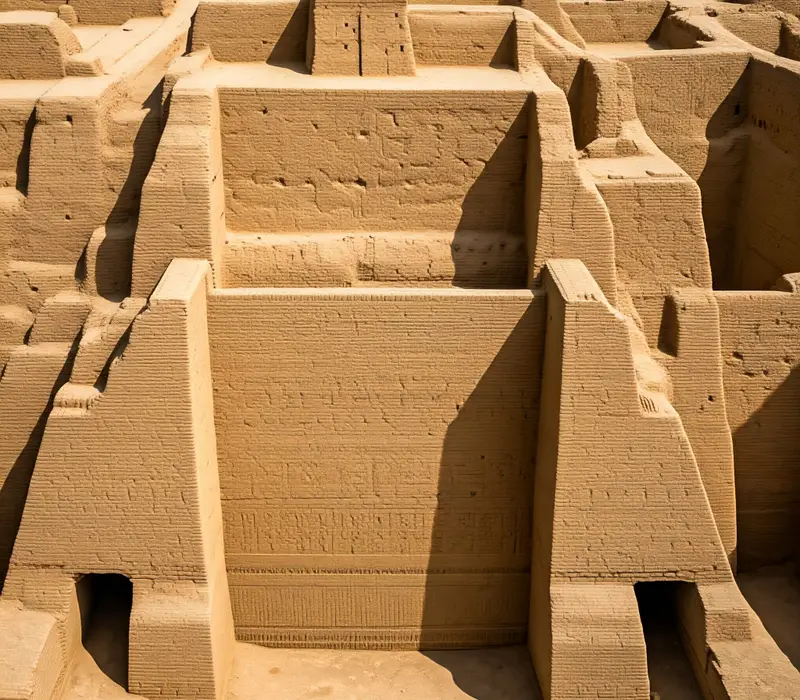Architecture in Mesopotamia: Ancient Building Techniques and Materials

Mesopotamia, known as the cradle of civilization, has left a profound legacy in the world of architecture. Located between the Tigris and Euphrates rivers, this ancient land developed architectural styles influenced by available materials, environmental conditions, and social needs. The brilliance of Mesopotamian builders lies not only in the aesthetic appeal of their structures but also in their innovative use of natural materials like mud bricks, lime, and wood, alongside advanced engineering techniques.
exploration of Mesopotamian architecture, shedding light on the distinctive features of ancient buildings, the materials used, and the role that climate and geography played in shaping these constructions. Travelers interested in Iraq can discover the remnants of this fascinating architectural heritage, including the palaces, temples, and ziggurats that stand as testaments to the ingenuity of ancient Mesopotamian builders.
---
Materials Used in Mesopotamian Architecture
Mesopotamian architects made the most of the materials available in their surroundings. The abundance of mud, lime (gypsum plaster), and reeds enabled the development of architectural styles that were both practical and suited to the region's harsh climate. However, the scarcity of wood in some areas, particularly in southern Mesopotamian cities like Ur and Eridu, posed challenges for builders.
1. Mud Bricks
Mud bricks were the primary building material in Mesopotamia. These bricks were made by mixing clay, silt, and straw, then drying them under the sun. The resulting product was not as durable as modern materials but was easily replaceable. Mud bricks were used to construct houses, temples, and palaces, and many walls were plastered with gypsum to protect them from weathering.
Advantages: Easy to produce and replace
Disadvantages: Prone to erosion, requiring regular maintenance
2. Lime and Gypsum Plaster (Shid)
To increase the durability of mud brick structures, Mesopotamian builders used lime and gypsum as plaster. This not only strengthened walls but also gave them a smooth finish, often decorated with paintings or reliefs.
3. Wood for Doors and Roof Beams
Wood was another essential material, but it was not available in abundance throughout Mesopotamia. Cities in northern regions like Nineveh had better access to wood from forests, while southern cities relied on trade to import timber. Wood was primarily used for doors, roof beams, and furniture.
---
Layout and Design of Mesopotamian Homes
The architecture of Mesopotamian homes reflects the practical needs of everyday life in a region with hot summers and cold winters. Most homes followed a simple layout, centered around a square courtyard, which served as the heart of the household. Surrounding this courtyard were various rooms used for sleeping, cooking, and storage.
Courtyards: Provided ventilation and light
Thick Walls: Insulated the interior against temperature extremes
Flat Roofs: Utilized as extra living space, especially during cooler evenings
These architectural elements not only made homes comfortable but also helped residents cope with seasonal changes in temperature.
---
Distinctive Features of Mesopotamian Architecture
Mesopotamian architects were known for their ability to combine functionality with aesthetic appeal. Their structures ranged from simple mud-brick homes to grand palaces and monumental ziggurats, each reflecting the cultural, religious, and social values of the time.
1. Palaces and Temples
Palaces served as the administrative centers of Mesopotamian cities and were often lavishly decorated with carved reliefs and statues. Temples, on the other hand, were built to honor the gods, with massive altars and sanctuaries where priests conducted rituals.
Famous Example: The Palace of Sargon II in Khorsabad
Design Elements: Columns, relief carvings, and large courtyards
2. Ziggurats: The Iconic Step Pyramids
Ziggurats are perhaps the most recognizable structures of Mesopotamian architecture. These towering, tiered buildings served as temples and were believed to connect heaven and earth. The Ziggurat of Ur is a prime example, attracting visitors today with its impressive size and historical significance.
Height and Scale: Often built on platforms to elevate them above surrounding buildings
Spiritual Function: Dedicated to the city’s patron god or goddess
---
Engineering Innovations in Mesopotamian Architecture
Mesopotamian builders were not only skilled architects but also ingenious engineers. They designed complex networks of canals, aqueducts, and dams to manage water resources, ensuring that cities had a steady supply of water for agriculture and domestic use.
Canals: Directed water from rivers to fields
Dams: Controlled flooding during rainy seasons
These hydraulic systems were crucial for the survival of cities in a region where rainfall was scarce, and the Tigris and Euphrates rivers were prone to unpredictable floods.
---
Impact of Climate on Mesopotamian Architecture
The climate of Mesopotamia played a critical role in shaping architectural styles. With hot summers, cold winters, and limited rainfall, architects had to design buildings that offered both insulation and ventilation.
1. Courtyard Architecture
To cope with the heat, most homes were built around internal courtyards. These open spaces provided natural cooling, as air circulated freely, while the surrounding rooms remained shaded.
2. Thick Walls and Small Windows
Thick mud-brick walls insulated buildings from temperature extremes, while small windows minimized heat gain during the summer months.
---
Famous Mesopotamian Sites to Visit Today
Travelers to Iraq can explore several ancient sites that offer a glimpse into the grandeur of Mesopotamian architecture. Some of the most popular destinations include:
The Ziggurat of Ur: Located near Nasiriyah, this site offers insight into the religious practices of the Sumerians.
Nineveh: Once the capital of the Assyrian Empire, Nineveh features impressive remnants of palaces and temples.
Babylon: Known for its hanging gardens and the Ishtar Gate, Babylon is a must-see destination for history enthusiasts.
These sites not only showcase the brilliance of ancient architects but also highlight the cultural and religious importance of architecture in Mesopotamian society.
---
Architecture in Mesopotamia was a product of necessity, creativity, and engineering expertise. From mud-brick homes with internal courtyards to the towering ziggurats that symbolized divine connections, Mesopotamian builders left an indelible mark on the history of architecture. Travelers to Iraq can explore these remnants of the past and witness firsthand the ingenuity of the architects and engineers who shaped the ancient world.